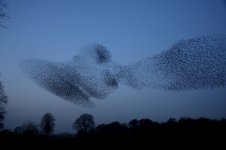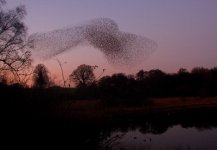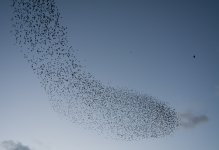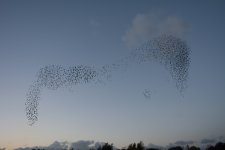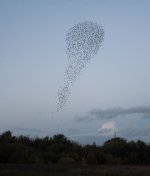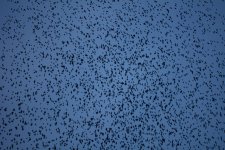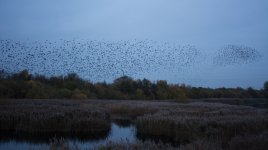-
Welcome to BirdForum, the internet's largest birding community with thousands of members from all over the world. The forums are dedicated to wild birds, birding, binoculars and equipment and all that goes with it.
Please register for an account to take part in the discussions in the forum, post your pictures in the gallery and more.
You are using an out of date browser. It may not display this or other websites correctly.
You should upgrade or use an alternative browser.
You should upgrade or use an alternative browser.
Murmurations (1 Viewer)
- Thread starter Matthewnm
- Start date
More options
Who Replied?Cheshire Birder
Well-known member
Budworth Mere is a good place to see them. Go about an hour before dusk and wait for them to start coming in.
CB
CB
David Smith
Warrington Lancs
From where you live I would think Marbury country Park is well worth a visit. If you look at my photo gallery you will see some photo's that I took from the hide close to the car park........I have attached 2 of them to this post.
Attachments
Pitvar
Well-known member
This thread got me back to Moore this evening - spent two hours at the eastern reedbed hide and was entertained by Jays, a Kingfisher, at least three Sparrowhawks, lots of squealing Water Rail, Little Grebes, Teal, Pochard, Tufted Duck, Herons and a Great Crested Grebe whilst I awaited the starlings.
When they did start coming in [from about 4.30pm] they were in small groups and a massive flock of birds was resting on the power lines to the east of Moore. Gradually some of them came in in flocks of a few thousand at a time to the reeds but there must be other roost sites nearby. Anyway as always a treat to watch and they did make some shapes - particularly when the Sparrowhawks attacked and then the "lightbulb" as they dropped into the reeds.
Makes a change doing bird photography at 18mm...if anyone's going the track to the hide was completely flooded so wellies would be good after heavy rain!
When they did start coming in [from about 4.30pm] they were in small groups and a massive flock of birds was resting on the power lines to the east of Moore. Gradually some of them came in in flocks of a few thousand at a time to the reeds but there must be other roost sites nearby. Anyway as always a treat to watch and they did make some shapes - particularly when the Sparrowhawks attacked and then the "lightbulb" as they dropped into the reeds.
Makes a change doing bird photography at 18mm...if anyone's going the track to the hide was completely flooded so wellies would be good after heavy rain!
Attachments
Cheshire Birder
Well-known member
Nice photos Pitvar!!
CB
CB
HughPulsford
County Bird Recorder Cheshire and Wirral
This thread got me back to Moore this evening - spent two hours at the eastern reedbed hide and was entertained by Jays, a Kingfisher, at least three Sparrowhawks, lots of squealing Water Rail, Little Grebes, Teal, Pochard, Tufted Duck, Herons and a Great Crested Grebe whilst I awaited the starlings.
When they did start coming in [from about 4.30pm] they were in small groups and a massive flock of birds was resting on the power lines to the east of Moore. Gradually some of them came in in flocks of a few thousand at a time to the reeds but there must be other roost sites nearby. Anyway as always a treat to watch and they did make some shapes - particularly when the Sparrowhawks attacked and then the "lightbulb" as they dropped into the reeds.
Makes a change doing bird photography at 18mm...if anyone's going the track to the hide was completely flooded so wellies would be good after heavy rain!
Excellent photos and records, please send in our estimated counts to [email protected] It seems Starling flocks are much diminished here in the North West and we need counts/estimates at any sites. They used to be in really huge numbers, but now they have split into smaller roosts, presumably to accommodate the roost site, ie a million at Rostherne would flatten the reed bed in a single night and then where do they go, so it seems they are being very savvy and only targeting sites that can hold their numbers...
and that means several sites spread across the area and well spread out, so any and all roost site info is gratefully received.
also any Pied Wagtail roost sites are also needed!
Thanks Hugh
Pitvar
Well-known member
Excellent photos and records, please send in our estimated counts to [email protected] It seems Starling flocks are much diminished here in the North West and we need counts/estimates at any sites. They used to be in really huge numbers, but now they have split into smaller roosts, presumably to accommodate the roost site, ie a million at Rostherne would flatten the reed bed in a single night and then where do they go, so it seems they are being very savvy and only targeting sites that can hold their numbers...
and that means several sites spread across the area and well spread out, so any and all roost site info is gratefully received.
also any Pied Wagtail roost sites are also needed!
Thanks Hugh
Happy to try and help Hugh - whats the best technique for starling counts - get a clear photo, take a count of a percentage of the flock and then multiply it up? The other issue for anyone counting from Moore is the huge gathering on the pylons over to the east as I'm not convinced more than a quarter eventually made it to the reed bed - some parties flew directly towards the Mersey instead I think.
Cheshire Birder
Well-known member
Happy to try and help Hugh - whats the best technique for starling counts - get a clear photo, take a count of a percentage of the flock and then multiply it up? The other issue for anyone counting from Moore is the huge gathering on the pylons over to the east as I'm not convinced more than a quarter eventually made it to the reed bed - some parties flew directly towards the Mersey instead I think.
There used to be a huge roost on the Runcorn-Widnes bridge so maybe they are going there.
CB
Pitvar
Well-known member
Still haven't driven over the bridge at the right time to check that roost but there was a large but un-showy roost at Moore today. Surprised me by being around 40 minutes earlier than a fortnight ago but dusk is that bit earlier and it was a cloudy afternoon. Sadly they only did one or two fly overs in any numbers then dived straight into the reeds - to the right this time and not into the central island. Most birds came in fast and low from the west this time in parties of a few hundred and none came from the pylons to the east.
At least one Sparrowhawk was successful and again the Sparrowhawks appearing signaled the Starlings weren't far behind!
Photos weren't good enough to attempt a count of the main flock but it was good to see plenty of other people there to enjoy the spectacle - short lived as it was.
At least one Sparrowhawk was successful and again the Sparrowhawks appearing signaled the Starlings weren't far behind!
Photos weren't good enough to attempt a count of the main flock but it was good to see plenty of other people there to enjoy the spectacle - short lived as it was.
Attachments
Similar threads
Users who are viewing this thread
Total: 2 (members: 0, guests: 2)




